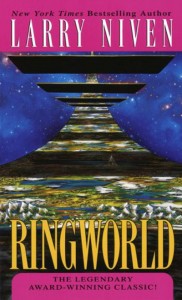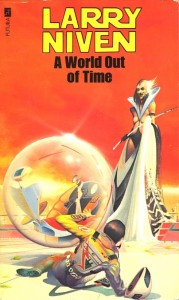Larry Niven Was Here (More Recommended Texts)
A while back I wrote a couple of posts recommending books that inspired me while I was researching Twinmaker (and contributed greatly to my PhD). Here’s another one, about the author who arguably set me on the path to becoming a science fiction writer, and who contributed to my already great fascination with the matter transmitter. . . .
 Few writers influenced me like Larry Niven. I don’t remember when or where I first stumbled across his work. It was probably the late 1970s in Darwin’s Nightcliff Public Library, which contained a large number of wonderful books by classic science fiction authors such as Arthur C. Clarke, Isaac Asimov, Bob Shaw, Philip K Dick and so on (very blokey, I know, but those were the times). The book I read first might have been Ringworld, one of the few books ever to win all three of the Hugo, Locus and Nebula Awards. It’s certainly a favorite of mine, and holds up very well compared to a lot of its contemporaries. It’s only four years younger than me.
Few writers influenced me like Larry Niven. I don’t remember when or where I first stumbled across his work. It was probably the late 1970s in Darwin’s Nightcliff Public Library, which contained a large number of wonderful books by classic science fiction authors such as Arthur C. Clarke, Isaac Asimov, Bob Shaw, Philip K Dick and so on (very blokey, I know, but those were the times). The book I read first might have been Ringworld, one of the few books ever to win all three of the Hugo, Locus and Nebula Awards. It’s certainly a favorite of mine, and holds up very well compared to a lot of its contemporaries. It’s only four years younger than me.
As well as inspiring my early attempts at voice, characters, plots–the lot, really–Larry Niven pointed me in a conceptual direction that I’ve been following ever since.
In 1966, the year before I was born, he published “By Mind Alone”, the first of many works exploring the practice of teleportation. It’s a charming tale that describes teleportation rather unscientifically as “the gentle art of wishing yourself from place to place”. Dosing up on beer and tranquilizers beforehand helps a great deal, apparently. But the laws of physics aren’t entirely violated. Potential energy is conserved in each jump, so you can heat up or cool down by jumping from one altitude to another–or be squashed like a bug when jumping from a speeding car.
The notion obviously stuck with him, because a couple of years later he gave a speech called “The Theory and Practice of Teleportation”, in which he discusses various applications of various types of teleportation, many of which appeared in subsequent works. Ringworld (1970) opens with the main character hopping from transfer booth to transfer booth around the world in order to extend his 200th birthday as long as possible (famously the wrong way around the world in the book’s first edition). Later, booths are superseded by more advanced alien “stepping disks” that allow open-air transfers, leading to all sorts of wonderful machinations in this book and the sequel written ten years later, The Ringworld Engineers.
But matter transmission take a back seat in this series of novels to more wondrous physical conceits such as Ringworld itself and the Puppeteer Fleet. Niven more deliberately explored the social consequences of this kind of technology in a series of short stories and novellas in the mid-1970s: “The Alibi Machine” (1973), “All the Bridges Rusting” (1973), “Flash Crowd” (1973), “A Kind of Murder” (1974), and “The Last Days of the Permanent Floating Riot Club” (1974). Of these, “Flash Crowd” is probably the most famous, credited as it is with being the inspiration for real-world “flash mobs”, but all of them are gems. So many ideas are explored in these series of stories–too many to list them all, but here are some examples:
Homes can be built anywhere on Earth, accessible by transfer booth, but when people put their booths in their homes, thieves are able to hack their way in, causing problems for the police. Physical getaways can be hard from such isolated houses because there are no roads to follow and old-style travel technology like helicopters are accessible only by the cops, except for those who enjoy it as a hobby. A hardcore booth user might not even think of a getaway on foot.
Young people used to a world full of booths don’t know what vehicle tracks look like or don’t remember looking both ways for traffic when stepping across a curb. The generation gap is captured neatly by means of dialogue in “The Alibi Machine”:
“You young ones don’t know anything about speed.” …
“I can go anywhere in the world at the speed of light.”
“Hell, that isn’t speed. Ever been on a motorcycle?”
Some people restless flick around the world without ever leaving a transfer booth. Crowds of people gather instantly every time something interesting happens, no matter how far away it is from where they started. Organised pickpockets take advantage of these unpredictable opportunities, along with other forms of criminal. Meanwhile, bridges rust from disuse or are covered with shops and landscaped, and the wilderness is overrun by tourists. Smuggling is an immense problem for customs officers, as is getting away from other people. Everywhere you go, they’re already there!
Space exploration is booming. So is recycling and the mass-transport of fresh water. The builders and planners of urban streets are out of a job, as are those who profit from slums. Clubs and hotels exist that look exactly the same, no matter where in the world you are (a bit like McDonalds and Hilton Hotels now). People hide booths in closets, and even in coats–the ultimate spy accessory. Weather travels with people until the doors of the booth open and different atomospheres mingle.
The details in these stories are endless. I’ve riffed on at least two of them in Twinmaker, sometimes as homage, sometimes because if you’re going to steal, you should always steal from the best.
 Niven also wrote a novel called A World out of Time (1976) that, while not about matter transmission per se certainly relies on it at the end. He posits that such a process might actually improve you slightly as you’re taken apart and put back together, by cleaning out your cells of bits and bobs that don’t belong in there, the detritus of everyday life. As the only one of Niven’s works that uses anything like d-mat, in the disassembly/reassembly sense (the others gesture at waveforms and total-object transmission), it’s also the only one that delves full-on into body horror imagery: the main character is at various points riddled with cancer, frozen, woken up in a new body (his brain having been minced up to provide RNA for his new brain’s memories), aged unnaturally, and then rejuvenated.
Niven also wrote a novel called A World out of Time (1976) that, while not about matter transmission per se certainly relies on it at the end. He posits that such a process might actually improve you slightly as you’re taken apart and put back together, by cleaning out your cells of bits and bobs that don’t belong in there, the detritus of everyday life. As the only one of Niven’s works that uses anything like d-mat, in the disassembly/reassembly sense (the others gesture at waveforms and total-object transmission), it’s also the only one that delves full-on into body horror imagery: the main character is at various points riddled with cancer, frozen, woken up in a new body (his brain having been minced up to provide RNA for his new brain’s memories), aged unnaturally, and then rejuvenated.
All in all, Larry Niven gifted us with an amazing exploration of the trope, a legacy that, at the very least, inspired one young author to give it a go.
Bonus quote: “I wouldn’t ride in one of the god-damned things.”
